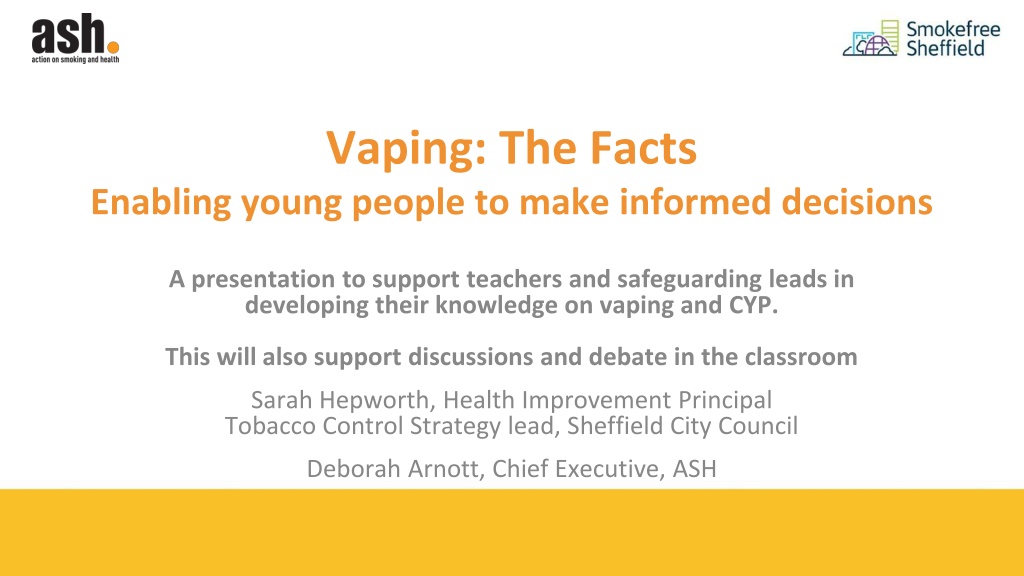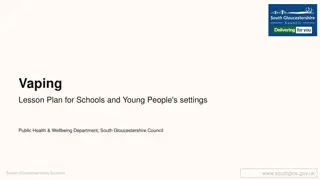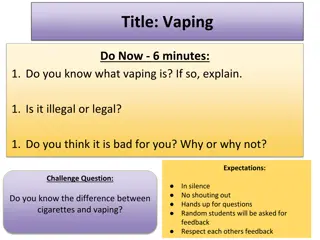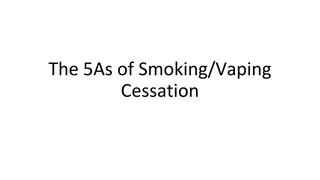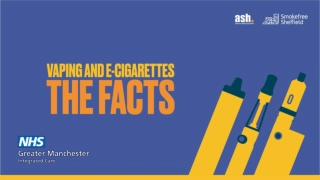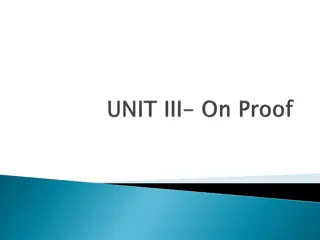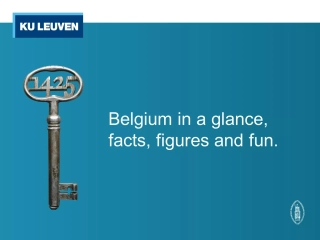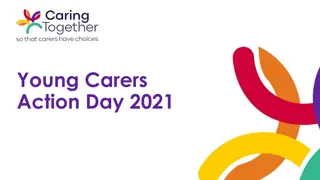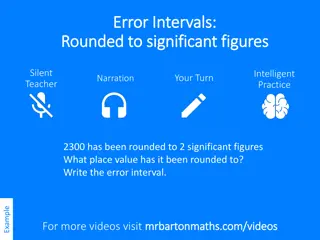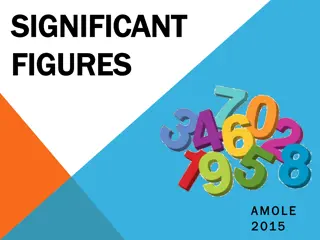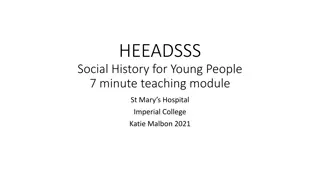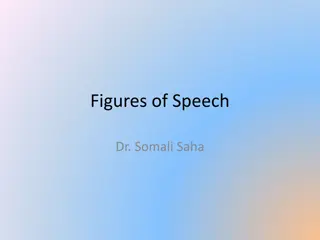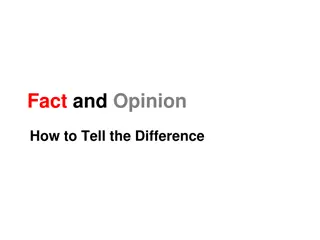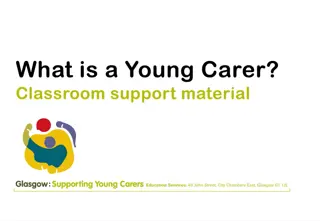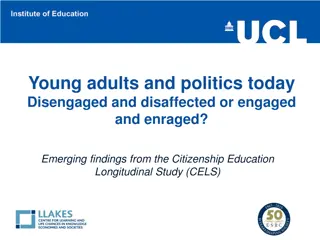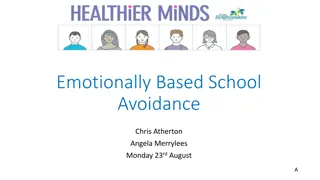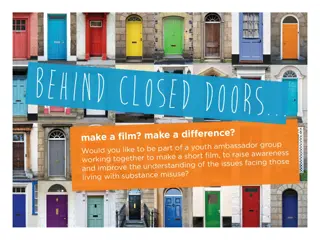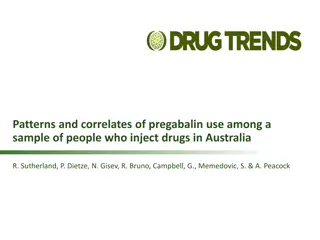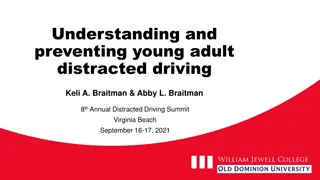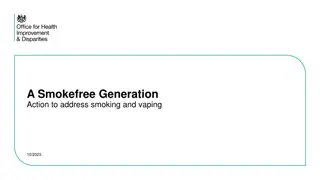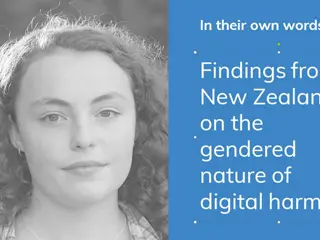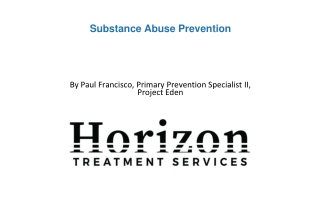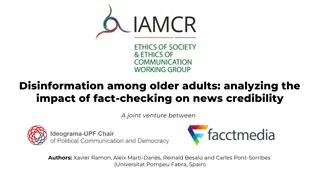Understanding Vaping Among Young People: Facts and Figures
Exploring the prevalence and trends of vaping among children and young people, this presentation provides insights into the use of electronic devices to inhale vapour. Topics include the rise in vaping rates, youth preferences for disposable vapes, common sources of vape supplies, and awareness of e-cigarette promotion. Additionally, the ingredients of vaping liquids and the need for informed decision-making are discussed to support teachers, safeguarding leads, and parents in educating and guiding young individuals.
Download Presentation

Please find below an Image/Link to download the presentation.
The content on the website is provided AS IS for your information and personal use only. It may not be sold, licensed, or shared on other websites without obtaining consent from the author. Download presentation by click this link. If you encounter any issues during the download, it is possible that the publisher has removed the file from their server.
E N D
Presentation Transcript
Vaping: The Facts Enabling young people to make informed decisions A presentation to support teachers and safeguarding leads in developing their knowledge on vaping and CYP. This will also support discussions and debate in the classroom Sarah Hepworth, Health Improvement Principal Tobacco Control Strategy lead, Sheffield City Council Deborah Arnott, Chief Executive, ASH
Teachers Toolkit Posters on vaping and CYP Animation on vaping and CYP and presentation to support classroom discussion and debate Teacher knowledge presentation to support lesson planning and equip teachers to be discussion ready Parents information leaflet which can be shared via newsletters and emails
ASH Smokefree GB youth survey on vaping prevalence among CYP: 2022 Overall vaping rates Current vaping among children 11-17 up from 4% in 2020, around the time of the first lockdown, to 7% in 2022 While the increase is a cause for concern, and needs close monitoring, 92% of under 18s who ve never smoked, have also never vaped and only 2% have vaped more frequently than once or twice Children under 16 are least likely to try vapes. 10.4% of 11-15 year olds have tried vaping, compared to 29.1% of 16-17 year olds. Among 18 year olds 40.8% report having tried a vape Use of vaping among 11-17 year olds who have never smoked remains low and largely experimental, while 7.5% of never smokers have tried an e-cigarette in 2022 only 1.7% report at least monthly use Use-of-e-cigarettes-among-young-people-in-Great-Britain-2022.pdf (ash.org.uk)
ASH Smokefree GB youth survey on vaping prevalence among CYP: 2022 Youth use of disposable vapes Single use disposable vapes are now the most popular product. Fewer than one in ten current vapers under 18 used disposable vapes in 2020, by 2022 it was over half, with Geek Bar and Elf Bar the most popular brands Sources of supply Despite it being illegal to sell vapes to under 18s, the most common source of supply for underage vapers is shops (47%) Promotion of vapes Over half (56%) of 11-17 year olds reported being aware of e-cigarette promotion, most frequently in shops, or online (Tik Tok, then Instagram were the most frequently mentioned sources)
What is vaping? Vaping is the use of an electronic device to inhale vapour derived from a heated liquid. The main ingredients are vegetable glycerine and propylene glycol, but most e-liquids also contain nicotine, which must be no more than 2% or 20 mg per ml, as well as small amounts of flavourings.
What is a vape device? There are a variety of vape devices (which are also known as e-cigarettes). The names and type of devices keep changing and new ones come on to the market frequently. Below are the main types of vapes currently available: vape bars shaped like a highlighter pen (usually single use and disposable but sometimes rechargeable and refillable with e-liquid capsules) compact pod devices shaped like a flash drive or pebble (either disposable, or rechargeable and refillable with e-liquid capsules) vape pens with a tank you fill with e-liquid, and a replaceable coil and rechargeable battery "cigalikes" designed to look like a cigarette (either disposable, or rechargeable and refillable with e-liquid capsules) customisable devices with variable power (these are more difficult to use and need more maintenance) Vaping to quit smoking - Better Health - NHS (www.nhs.uk)
How do nicotine vapes help smokers quit? Smoking delivers nicotine rapidly to the brain, which makes it highly addictive. Cravings for nicotine among those addicted can make people feel stressed, restless, irritable and unable to concentrate. Like nicotine patches and gum, vapes containing nicotine are a useful aid to quitting as they deal with the cravings smokers get when they try to stop. Nicotine vapes help smokers quit by replacing some of the nicotine they used to get from cigarettes and also by mimicking the hand-to-mouth action of smoking.
How do nicotine vapes help smokers quit? Nicotine replacement therapy such as gum and patches are licensed by the Medicines and Healthcare products Regulatory Agency for smoking cessation, not just by adults but also by children from age 12 upwards. Nicotine vapes are not yet licensed as medicines but are proven effective and have become the most popular quitting aid for smokers in recent years. However, vapes are not for recommended non-smokers, particularly children.
What are the concerns with vaping and children and young people? Most children and young people don t vape or smoke. However in 2022 the number of 11 17-year-olds in the UK using vapes and e-cigarettes rose to 7% compared to 4% in 2020. Regular vaping is mainly confined to children who currently smoke or have done in the past. The increase in youth vaping has coincided with the arrival on the UK market of a new category of cheap and attractive disposable vapes that have proven particularly popular with children and young people and have been promoted extensively on social media.
Nicotine vapes and dependency in Children and Young People Dependence on vaping appears lower than on smoking for young people. Most vaping is experimental with regular vaping mainly confined to children who also smoke or used to smoke. Most young people in the UK who try vaping have not become addicted to nicotine.
Smoking vs vaping Smoking is much more harmful than vaping. Tobacco smoke contains 7,000 chemicals including carbon monoxide and tar, and a sticky soup of around 250 toxic chemicals (more than a quarter of which are known to be carcinogens), causing disease, disability, and early death.
Vapes are not harmless The levels of exposure to cancer causing and other toxicants are extremely low in people who vape compared with those who smoke but there is still some exposure Short-term effects can include coughing, headaches, dizziness and sore throats. The long-term effects are, as yet, unknown. Our advice to children and young people is: DON T SMOKE? DON T START TO VAPE.
Question! Why do you think children try vaping?
Reasons for vaping by smoking status I am trying to quit smoking I use them instead of smoking Other people use them so I join in I like the flavours Just to give it a try 0% 20% 40% 60% 80% Current tobacco smoker Former tobacco smoker Never tobacco smoker ASH/YouGov Smokefree GB Youth Survey 2022
Question! Where do you think children and young people who vape get them? And what can we do about this?
For 11-17-yr-olds, shops are still most common route of purchase for tobacco and vapes Purchased from friends or other informal source The internet Given Street markets Shops 0 10 20 30 40 50 60 E-cigarette Source Cigarette Source ASH/YouGov Smokefree GB Youth Survey 2022
Question! Where is vaping being promoted online and what can we do about this?
11-17 year olds who had seen e-cigarettes promoted online, where did they see them? 50% 40% 30% 20% 10% 0% TikTok Instagram Snapchat Facebook Twitter Somewhere else Don't remember ASH/YouGov Smokefree GB Youth Survey 2022
The law and vaping Vapes and vaping products containing nicotine, like tobacco, are age restricted. It s illegal to sell them to under 18s, and for adults to buy them on their behalf. Those who knowingly sell vapes to under 18s don t care who they sell to and they are just interested in making money. If you know of anyone who does sell vapes, or tobacco illegally, you can report them to trading standards through the Citizens Advice online portal: www.citizensadvice.org.uk/consumer/
Regulation of vapes to protect health In the UK we have tight regulations around the strength of nicotine allowed in vapes and they must carry health warnings on the packaging E-cigarettes: regulations for consumer products - GOV.UK (www.gov.uk). Vaping products containing nicotine are regulated by the Medicines and Healthcare products Regulatory Agency (MHRA), which provides advice for consumers. They also must not contain vitamins, stimulants such as caffeine or taurine, colourings and chemicals which are carcinogenic, mutagenic and reprotoxic in their unburnt form.
Regulation of vapes to protect health Sales to those under 18 are illegal, but to be legally sold in the UK nicotine containing e-cigarettes must also: Contain 20 mg/ml or less of nicotine (equivalent to 2% or less) Carry the health warning This product contains nicotine which is a highly addictive substance . Be notified to the MHRA and listed on its website. In addition there are a number of ingredients which are prohibited in nicotine- containing e-liquid, including vitamins, stimulants such as caffeine or taurine, colourings and chemicals which are carcinogenic, mutagenic and reprotoxic in their unburnt form.
Advertising Advertising of all tobacco products is illegal. Advertising of nicotine-containing vaping products is prohibited on broadcast media (TV and radio); and in newspapers, magazines and periodicals; online media and some other forms of electronic media (this includes social media). If you see advertising for vapes that you feel is trying to encourage children and young people to try vaping, you can report it to the Advertising Standards Authority www.asa.org.uk. Non-commercial public health campaigns promoting vaping as an alternative to smoking are permitted.
How much nicotine is there in vapes compared to cigarettes? Disposable vapes DO NOT contain as much or more nicotine as a packet of 20 cigarettes. Comparing like with like, a UK standard 2 ml disposable vape contains 40 mg of nicotine; an average pack of 20 cigarettes contains 250 mg of nicotine, which is more than six times as much. For both smoking and vaping, a small proportion of the nicotine content is absorbed by the user and depends largely on how a cigarette or vape is used, rather than what it contains.
How much nicotine is there in vapes compared to cigarettes? A packet of cigarettes takes between 160 and 320 puffs to smoke. Popular disposable vapes, such as Elf Bar and Geek Bar, are said to contain around 600 puffs, but puffs on vapes ARE NOT equivalent to puffs on cigarette.
Diacetyl and Popcorn Lung You may have heard of popcorn lung , a serious but rare respiratory disease so-called because it was found in popcorn factory workers, who had been exposed to high levels of exposure to diacetyl, which was used to give popcorn a buttery flavour. Some vapes were found to contain diacetyl but in very small quantities, not the large quantities associated with popcorn lung . However, as a safety precaution it has been banned from vapes in the UK as are other ingredients that pose a risk to human health.
How does vaping harm the environment ? Single-use vapes contain batteries and difficult to recycle plastics. Approximately 1.3 million disposable vapes are thrown away every week in the UK: enough to cover 22 football pitches. These break down in landfills causing dangerous chemicals to pollute the soil and water. These chemicals can cause harm to humans, animals and the environment.
What about the impact of tobacco on the environment? Tobacco growing, curing and manufacturing pollutes the environment, causes soil degradation, biodiversity losses, and deforestation. Tobacco cigarettes are the most littered item and the toxic chemicals they contain pollute our pavements, parks, soil, rivers, and the sea with devastating consequences.
Impact of tobacco on the environment Globally the tobacco industry manufactures the equivalent of six trillion cigarettes each year, using 5.3 million hectares of land. Every year tobacco costs more than 8 million human lives, and 600 million trees, and 4.5 trillion cigarette filters pollute our pavements, parks, soil, rivers, beaches and oceans. Tobacco produces 25 megatons of solid waste, 55 megatons of waste water, almost 84 megatons of CO2emissions to climate change approximately 0.2% of the global total. More information:
Our advice Vapes are helpful quit aids to support smokers to stop Our advice to children and young people and non smokers is: Don t smoke? Don t start to vape.
Debate and discussion Key questions: What do they think about smoking ? and what do they think about vaping ? what is the difference? Do they know people who smoke or vape? Why do they think people smoke or vape?
Debate and discussion Key questions: Discuss the different reasons why children may smoke or vape give examples such as wanting to fit in, curiosity, stress. Talk through effective ways to respond if they ever feel pressured to try either and practise responding together. More information can be found here to support these conversations - Feeling pressured to take drugs? Here are 10 ways to deal with it | FRANK (talktofrank.com). Explain the facts. Discuss why nicotine vapes are not for non-smokers and children but are an effective quitting aid for adult smokers.
Debate and discussion If a child confides that they are a smoker or a vaper try to understand why they are smoking or vaping by asking questions like What do you enjoy about smoking or vaping? Or How does smoking or vaping make you feel? . Understanding this might help you to understand their needs and discuss other ways to meet their needs. Make a referral, where appropriate, to the school nurse, pastoral lead, safeguarding lead who can then seek support re: vaping or stopping smoking Additionally children and young people can be directed to Talk to FRANK telephone support 0300 123 6600 for confidential advice Provide information on the school smoking and vaping policies - children should not be excluded from school for vaping or smoking, unless it is associated with other disruptive behaviour which justifies this.
Further reading and helpful info www.smokefreesheffield.org ASH-brief-for-local-authorities-on-youth-vaping.pdf www.nhs.uk/better-health/quit-smoking/vaping-to-quit-smoking/ https://ash.org.uk/uploads/Use-of-e-cigarettes-among-young-people-in-Great-Britain-2022.pdf Vapes | FRANK (talktofrank.com) https://ash.org.uk/uploads/ASH-guidance-for-school-vaping-policies.pdf https://www.gov.uk/government/publications/nicotine-vaping-in-england-2022-evidence-update
